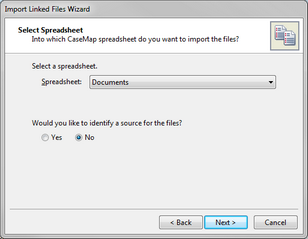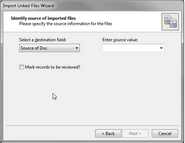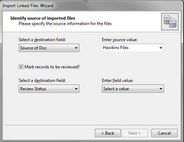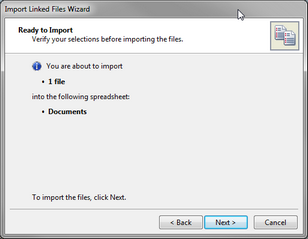The Import Linked Files Wizard guides you through the process of importing one or more documents/files into your case. The wizard will create a new record for each file you select to import. You can select one or more files, or a folder of files to import. If a folder contains sub-folders, all files in each sub-folder will be selected for the import as well. CaseMap also allows you to specify the source of the files that are imported.
CaseMap recognizes duplicate documents imported from the same folder. However, if you have the same document stored in two folders, CaseMap will not recognize the duplicate and will create a new record and link to it in the other folder location.

|
The import linked files wizard does not import meta-data from the document. You can use DocManager to import Bates Numbers applied to PDFs by Acrobat, or by using Acrobat and the CaseMap Bates Stamp tool.
|
You can choose to remove files during the import, particularly if a file seems too large. Large files will slow the import process during a bulk import.
You can cancel the import at any time. CaseMap will send a message indicating how many files were successfully imported before the process was canceled.
After the import, CaseMap indexes all new file content. You can begin searching the updated case data as soon as the index process completes. For more information, see About the case index.
You can import the following file types:
| • | Microsoft Office files (.doc, .docx, .xls, .xlsx, .ppt, .pptx, .eml) |
| • | Image files (.tiff, .tif, .gif, .jpg, .jpeg, .bmp, .emf., and .wmf) |

|
Once a file has been imported to the Documents spreadsheet, click the paperclip icon once to display the link/path to the object record. If you double-click on the paperclip icon, the object record opens.
|
| 1. | On the File menu, click Import and then click Import Linked Files from a Folder. |
| 2. | When the Import Linked Files Wizard opens, click Next. |
| 3. | In the Select Files to Import dialog box, click one of the following: |
| • | Add Files to select one or more files to import |
| • | Add Folder to import all files within a folder |


|
CaseMap identifies duplicate files based on directory paths. If a file in a folder has already been added to the case, the document will be skipped during the import process. If you have a file stored in two folders, CaseMap will not recognize the duplicate and will create a new record and link to it in the other folder location.
|
| 4. | In the Select Files to Import dialog box, navigate to the folder where the files are saved. |
If you selected Add Folder, you will navigate to the folder when the Browse for Folder dialog box displays.
If the folder contains subfolders, click Yes in the message box to import all files in each subfolder.
| 5. | Select the files you want to import, then click Open. |
The files now display in the Selected files box.
| 6. | Review the files in the Selected files box to ensure that you want to import them. |
If you want to delete one or more files selected for the import, click the Remove Files button.
If you want to delete all files selected for the import, click the Remove All button.
| 7. | Click Next to open the Select Spreadsheet dialog box. |

| 8. | In the Spreadsheet drop-down list, click the spreadsheet for which you want to import the files. |
| 9. | In the Would you like to identify a source for the files? area of the dialog box, click Yes to identify the source of the files, or click No if you do not want to identify the source of the files. |
| 10. | Perform one of the following: |
If you clicked Yes, click Next to continue.
If you clicked No, proceed to Step 16.
| 11. | In the Identify source of imported files dialog box, the Select a destination field dialog box uses Source of Doc as the default field entry. |

| 12. | In the Enter source value box, use the drop-down arrow to select/enter a source value up to a maximum of 35 characters. |
| 13. | Optional: Select the Mark records to be reviewed? check box to identify records that are to be reviewed. |
If the Mark records to be reviewed check box is selected, the 'Select a destination field' is displayed.

| 14. | In the Select a destination field dialog box, Review Status has been entered as the default value. |
| 15. | In the Enter field value box, enter/type in a field value. |
| 16. | Click Next to continue. |
| 17. | In the Ready to Import dialog box, review the files and spreadsheet you selected for the import. |

| 11. | Click Next to initiate the import process. |
| 12. | In the Completing the Import Linked Files Wizard dialog box, review the number of files imported, then click Finish. |
The new records display in the selected spreadsheet.
| 13. | In the appropriate spreadsheet (e.g., Documents), click the paperclip icon next to the imported record once to display the link/path of the object record, or double-click on the paperclip icon icon to open the object record and verify its content. |
|





